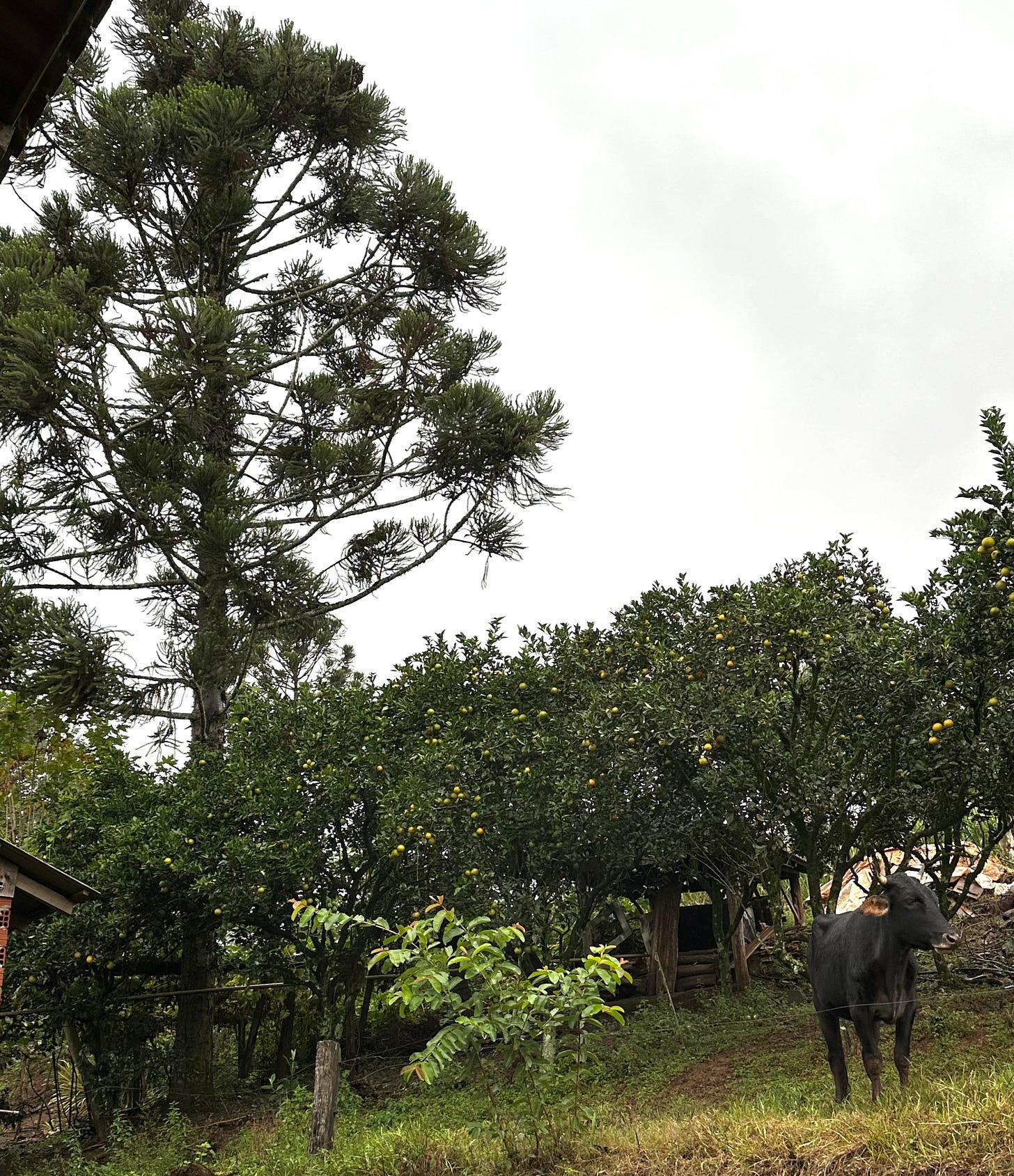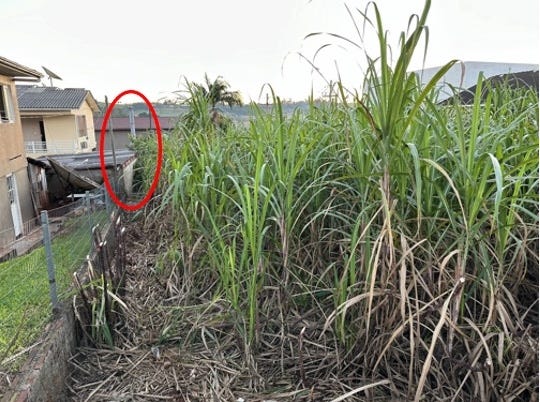In the hour or so that I sat chatting and sipping chimarrão—the ubiquitous erva mate tea that is a symbol of gaúcho culture—with Tuco and his wife Cristiane1, three different people stopped in to buy cachaça. The couple was apologetic, saying nos temos só novinho, we only have new. They had sold out of last years cachaça weeks before, and their customers were getting restless. So, even though everyone I have talked to so far agrees that cachaça tastes better once it has had a few weeks to rest, and even though their sugar cane wasn’t quite ready to harvest and therefore wouldn’t yield as much alcohol, they had already started cutting cane, making cachaça, and selling it pretty much directly out of the still.
The process begins in the fall, usually around mid-June. Tuco and Cristiane cut the sugar cane that they grow on their land by hand with machetes, and crush it with a 100-year-old motor-driven engenho—though Cristiane remembers not so long ago when she had to turn a hand crank for an hour and a half to crush enough cane to fill one alembique, or still pot.
They seed the fermentation of the cane juice with a mixture of bread yeast and wheat or corn flour that they transfer from one batch of juice to the next, over and over throughout the course of one season. They make cachaça for about 3-4 months out of the year when the cane is mature, and they hope to make enough to satisfy their customers until the next harvest. During the rest of the year, they are farming soybeans, wheat, and corn, tending a handful of beef cattle, gathering eggs and making fresh orange juice from the fruit in their orchard.
I have met a lot of family farmers like Tuco and Cristiane across Rio Grande do Sul, and the scene I witnessed at their farm is often repeated. We will be chatting as a car pulls up and someone ambles into the yard looking for cachaça. One producer had a bucket of full 2-liter bottles (called litrão) sitting on his porch, with cash left behind on the honor system. Some producers only sell simple, un-aged cachaça prata, while others have a range of cachaças, aged for different amounts of time in different types of wood, and even liqueurs made with cachaça, sugar, and various fruits, herbs, and spices like cinnamon, fig leaves, or burití, a palm fruit native to southern Brazil.
Most of the farmers I have talked to have between 5 and 25 hectares of land, and they plant between a half and a full hectare of it in sugar cane if they are relying mostly on family labor. One hectare of cane seems to be about the natural limit of what a family (husband and wife, sometimes an adult child, nephew, or cousin) can harvest on its own, without having to bring in day laborers during harvest season. Any more than that and you need about one additional person for every hectare of cane.
Harvesting cane in this region is very hard work; it is all cut with a machete by hand. The soil and topography don’t lend themselves to mechanized harvesting and even if they did, the families here don’t have the capital to invest in that kind of equipment, especially for such a relatively small area of land. And so there is a sort of naturally self-limiting cycle: a family can’t afford mechanized harvesting of cane because their area is small, and the area planted to cane is limited by the labor required to harvest it.
Like Tuco and Cristiane, none of the farmers I’ve met produce only cachaça. Instead, the spirit is part of a diversified farm economy that also includes wheat, corn, soy, tobacco, cattle, a kitchen garden, an orchard, and a few chickens.

While some producers use sugar cane to make other things like melado (a type of sugar syrup similar to molasses) or açucar mascavo (brown sugar), cachaça yields by far the best return. Plus, unlike these other derivatives of sugar, it can be stored for long periods of time, providing a steady source of income throughout the year.
So when I see a patch of cane growing anywhere now, especially a small one, I can pretty much assume that there’s a cachaçaria nearby. Even if they don’t make it themselves, there’s probably a neighbor who will turn cut cane into cachaça for a 50-50 split (60-40 if the cachaçeiro has to go pick up the cane).

Not only is cachaça by far the most profitable among the possible uses of sugar cane, it is the most profitable product on the farm as a whole. For those who can still manage to make it—and there are fewer and fewer every year—cachaça is crucially important to the family farmers’ income. Prices are steady, unlike notoriously volatile commodities like corn and soybeans whose prices are set on international markets and influenced by policies and weather events happening thousands of miles away. The customer base is steady, as these families are known the quality of their cachaça, which has been honed through generations of knowledge, experience, experimentation and innovation.
There’s no shortage of folks looking to buy cachaça de alembique, a special spirit produced in small batches from freshly pressed cane juice, very different from the large-scale industrial brands like 51 and Ypióca that Americans are most familiar with. There is only a shortage of workers to cut the sugarcane. The producers are getting older, and manual labor in countryside is harder and harder to find. And so, these aging farmers are harvesting less cane and making less cachaça each year.
I have asked farmers like Tuco and Cristiane if, given cachaca’s profitability, they have any desire to increase their production. If labor wasn’t an issue, especially since they can barely make enough to satisfy their customers as it is, would they be interested in expanding their operation? Sure, I suppose so, they say. They know they would have no problem selling more, but it’s a bit of an ambivalent yes. We are getting older and cutting cane is very hard work. If someone else harvested all the cane and all we had to do was sit by the alembique and tend the fire and drink chimarrão, why not?
But this isn’t a realistic option, and the lack of workers willing and able to cut cane isn’t the only reason. Unlike corn or wheat or soybeans, nearly all of the cachaça de alembique produced in Rio Grande do Sul is sold under the table, whether it’s 1,000 liters a year or 150,000. These sales—a matter of survival for the producers that I have met—are illegal in the eyes of the federal state.
Home distilling happens at varying levels of illegality everywhere in the world. In most states in the US it is illegal to distill spirits at home period, whereas in other countries (like Romania) the quantity may be limited, or it may be legal to distill as long as you don’t sell it (like India). In my next post I will try and untangle the Gordian Knot of cachaça regulation here in Brazil. It is a story that is both similar to and more complicated than the other places I have been as I’ve researched this project. You, dear reader, may need to pour a drink for that one.
Not their real names.









I guess I've mainly drunk cachaça in caipirinhas, and the proverb I always heard was "the worse the cachaça, the better the caiprinha", because you want it tasting raw and funky rather than smooth. So I realize I've never really looked for aged or otherwise fancy cachaça: it just didn't seem necessary.